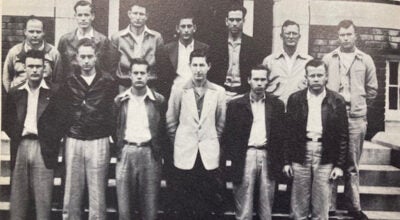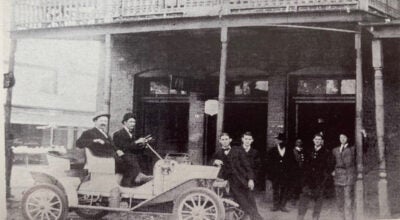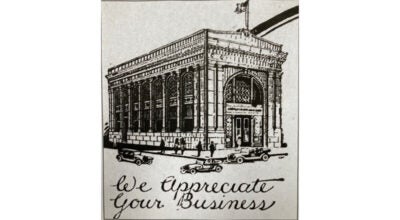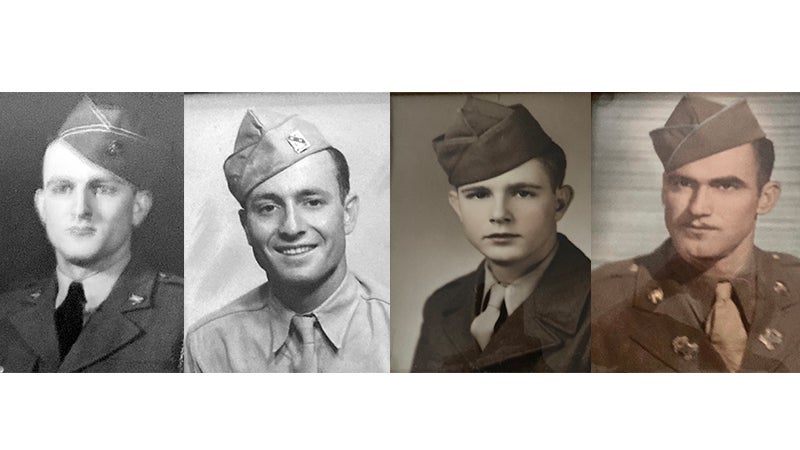Remember When: Pictures of historic buildings
Published 7:29 pm Friday, June 19, 2020
|
Getting your Trinity Audio player ready...
|
We found some interesting pictures this week at the Three Notch Museum, the former Central of Georgia Depot on Historic Central and Tisdale Streets. Built in the spring of 1900, the structure, the oldest wooden building remaining in downtown Andalusia, was restored and converted to a local history museum in the mid 1980s by the Covington Historical Society with the help of many “Friends of the Museum.”
This 1910 picture of the Prestwood Building constructed on what was called the “Public Square” at the time was taken by local photographer George W. Cumming. The occupancies of the offices housed in this significant structure are written on the back of the picture.
The upstairs was occupied by Dr. Ed L. Gatlin, dentist; Dr. T. Q. Ray, M.D.; and Attorney Morgan Prestwood. The downstairs business houses included A. M. Riley, druggist; the Z. D. Studstill movie house; Mrs. E. A. Kirpatrick, millinery; and Mr. Frank Shaver’s store (later to be the Wilder’s Mercantile Co.).
The railroad district photograph was probably taken in the 1970s based on the automobiles shown at the loading dock of the Sessoms Grocery Co. The power plant and the Andalusia Manufacturing Co. buildings appear to be in sturdy condition probably with a lot of activity in and around the RR tracks where building materials were shipped in. I remember it well when late businessman A. Reid Merrill, one of the owners of Andalusia Manufacturing where windows, doors, cabinets, mantels, trims, and millwork that went into “hump-teen dozen” homes built around these parts, used to call himself “the old dog down by the tracks!” His father E. R. Merrill and uncle W. C. Merrill, their descendants, and their companies are known as the “early builders of the town.”
The picture of East Three Notch Street most likely taken from atop the 1895 courthouse in the middle of the square can be dated to about the same era as the Prestwood building – probably between 1910 and 1917 prior to the paving of the city streets (early 1920s) and prior to the razing of that particular courthouse (1917-18). Shreve and Sons occupied that building that now houses Murphy and Murphy, Attorneys at Law. Homes can be seen in the photo, and as I have mentioned before, residences are located within one block of the Court Square.
A few blocks to the east, the large oak trees that once lined both sides of East Three Notch providing shade and beauty can be spotted. There are no steeples to be seen from Methodist or Baptist churches at that point in time since the Methodists were still worshiping in a stately wooden building on Church Street and the Baptists were in a new brick church with stained glass windows on Crescent Street. (Look for the top of the Methodist steeple in the Prestwood Building photo.)
Notice that there are no sidewalks – only what appears to be a boardwalk on the south side of the street. There are numerous stories about the need for boardwalks around the square because of the muddy streets. The current paved streets and miles of sidewalks should make us have an appreciation for the town leaders of over 100 years ago who helped build up the downtown we have today. This writer is determined to never take that for granted. As they say, “Gone but not forgotten.”
Balconies must have been fashionable and functional on the two-story downtown buildings. The one shown in this likeness is of the Henderson building. Various tenants have occupied that building including hardware stores, dentists, jewelers, druggists, telephone switchboards, and attorneys. The Hendersons were in the banking business as well as the lumber trade. Henderson and Waits were business partners in Sanford and down in Florida as well.
As you carefully study this building’s picture, notice the chimneys on the street side. It makes us imagine how cold some of those offices might have been in the winter time with coal and wood being the source for heating. Additionally, there were bound to be many hitching posts and watering troughs around the square for the horses and mules pulling wagons and buggies in that day and time.
Other businesses around the square were the saloons that were convenient for refreshment by mule skinners, horse traders, and traveling salesmen of the day who arrived by train. If I know the mindset of the abstaining Baptist women of the early 1900s, they took care of that situation since inebriated souls who wandered around the boardwalks made it quite bothersome for ladies who were shopping at the drug stores, the furniture stores, the markets, the bakery, and the clothing stores around town. Imagine those club ladies who established the public library and the ones who landscaped the center of the square with the chinaberry trees and flowers while having to deal with intoxication of certain ne’er-do-wells. Barroom brawls downtown just weren’t going to happen in “the dimple of Dixie” after the “cowboy town” of the late 1800s turned into more of a classy “uptown” when the new courthouse got built in 1917-18.
Those are the observations of this writer when I Remember When all the stories read by writers of a generation now gone and programs heard at historical society meetings for the past 35 years or so. Please take the opportunity soon to visit the Three Notch Museum. This is an invitation for you, your children, and grandchildren, a neat place to discover our town and county’s history. Opening times are Mondays, Tuesdays, and Wednesdays from 9:00 – 2:00 and by appointment only. Take a picnic lunch or snack and sit on the front porch of the log cabin while you reminisce of yesteryear as these times go by. The CHS appreciates your interest and support as the organization endeavors to continue preserving and publicizing the local history.
Sue Bass Wilson, AHS Class of 1965, is a local real estate broker and long-time member of the Covington Historical Society. She can be reached at suebwilson47@gmail.com.








